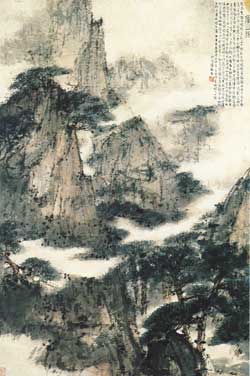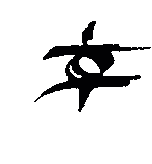Picasso used to say the interesting thing about Cézanne was his anxiety – “Le Doute de Cézanne,” Merleau-Ponty called it. With Fu Baoshi the anxiety’s a lot harder to define: if there’s anything like second thoughts in the later work he produced glorifying Mao-Tse-Tung, they’re well hidden. Fu drank himself to death in 1965, a year before the Cultural Revolution began; another Chinese painter, Shi Lu, was not so lucky: he was sent to a labor camp under suspicion that his painting of Mao standing silent upon a peak in Shaanxi revealed a secret wish to see the Great Helmsman fall off.
Anxiety’s not a quality you’d associate with the type of traditional Chinese painting Fu practiced throughout his career: majestic mountains, tiny figures in the distance. The traditional Chinese painter had once been required to embrace the Confucian imperative that representations are presentations of his own moral balance in the face of an unstable world, but when Fu began painting, in the nineteen-twenties, his patrons were more likely to be merchants and businessmen for whom these ideas were interesting, if at all, in an abstract, antiquarian way. The first gallery in this show is devoted to Fu’s attempts to work in the style of various old masters, as recommended by the old critics of the late sixteenth century: It’s all very well done, but it’s all lacking in purpose. Fu studied briefly in Japan and, like many Chinese artists of his generation, had his first success with Japanese collectors: which is to say that his relationship to the traditions of Chinese landscape painting was at one remove; and that the remove was further shadowed by a particular modernist anxiety that was to shadow much of Chinese Art in the twentieth century: the suspicion that traditional landscape painting with its twisted, roving perspective, its insistence on the ideal over the real, was hopelessly behind the times, outpaced by the “scientific,” “rationalist” systems of Eurocentric painting – not to mention various forms of marxist materialism.
In fact the questioning of visual rationalism by Chinese artists goes back a thousand years or so; the major difference between Western and Chinese artists is, that the Chinese don’t respond as a rule with anxiety but with humor, which is another form of anxiety to begin with. Think of Mi Fu, at the turn of the twelfth century, with his ironic use of the “drunken” style as a comment on his own lack of control; or the monk Shitao’s bitter self-sarcasm at the turn of the eighteenth. In twentieth-century China think of Qi Baishi, who paints traditional sugarloaf mountains with a few airplanes flying over them. In twentieth-century Japan think of Munakata Shiko.
Unfortunately, Fu Baoshi lacked a sense of humor; he spent much time studying Shitao’s writings without seeming to grasp Shitao’s wit. For lack of an understanding of Shitao’s moral imperative he focused on brush technique, very much like those painters who study Rembrandt’s bravura brushwork without grasping the ethical imperatives that take it beyond mere sprezzatura.
Michael Sullivan wrote of Fu Baoshi, rather testily, that he only painted three topics: landscapes, people, and people in a landscape. The first category – landscapes – was by far Fu's most successful, especially the series of landscapes he painted as a refugee in Chongxing, in Western China during the Japanese Occupation, in the late ‘thirties and ‘forties:

Here Fu gives free rein to his interest in formal experimentation: to present distance, for instance, through the superposition of brushstrokes or their fading tones, and these are goals with which Westernized artists would be comfortable; as to the accuracy of the landscapes themselves, Fu followed the traditional Chinese argument that shensi (likeness in spirit) was more important than xingsi (likeness in form); unfortunately, by the mid-fifties that preference had a distinctly counter-revolutionary cast. The correct revolutionary artist was the one who showed the proper attitude by inserting the proper figures in his landscape: workers and Party cadres instead of monks and mandarins. As the introductory signage to this exhibition explains, “The propagandistic nature of these images does not, however, compromise the integrity of [Fu’s] innovative spirit.” If by that the curators mean that Fu continued to innovate in the representation of landscape, yes. If by that they claim his paintings retained their integrity in the sense that the narrative elements are fully integrated – then absolutely not. Fu’s drawing of Mao swimming in the Yang-Tze river is particularly gauche: the strokes meant to represent a vast expanse of water lead one to suspect that Fu had a secret wish to see the Great Helmsman strangled by weeds, and this has nothing to do with the fact that it was Mao that Fu represented, it’s that he couldn’t blend the two forms of likeness: the realistic image of Mao bounces up and out of the sea of abstracted strokes like a cork that’s been pushed too hard. Significantly, Fu’s drawing was copied from a widely disseminated photograph, which is to say that, like nineteenth-century European artists, Fu was at loss to find a niche for painting that was not vulnerable to photography.
About Fu’s third genre – the figure – the less said the better; or perhaps more should be said, that’s not said in this show; Fu’s human figures are taken, mostly, from traditional Chinese images of sages and goddesses; once again, they’re technically clever; once again they have nowhere to go as narrative or content; but give them either, and you begin to see the possibilities in what was to become the most important, most widespread, most ironic form of Asian art today: I refer of course to Manga and cartoons.
Seriously: you thought I meant Ai Weiwei?
- PW.
WOID XX-22.
Le doute de Fu Baoshi
